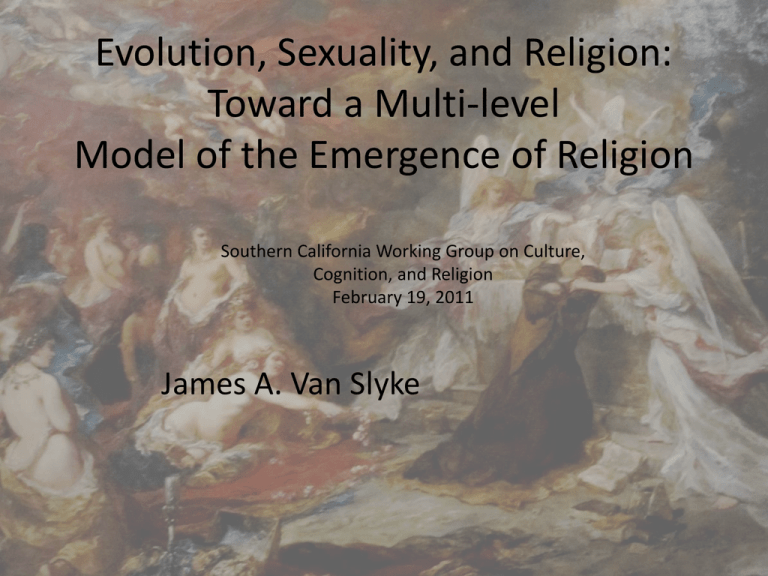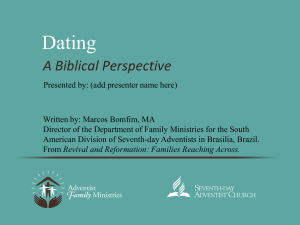
Evolution, Sexuality, and Religion:
Toward a Multi-level
Model of the Emergence of Religion
Southern California Working Group on Culture,
Cognition, and Religion
February 19, 2011
James A. Van Slyke
Religion
By-Product or Adaptation?
• By-product theory
– Religion is a secondary, unintentional by-product
of cognitive adaptations designed for other
functions
• Adaptation theory
– Religion serves some type of adaptive function in
promoting reproductive success and survival in
evolutionary history
Religion:
By-Product and Adaptation
• Religion is a very diverse and complex
phenomena
• Different aspects of religion evolved as a
consequence of both factors
• Multi-level Approach
– Cognitive factors
– Individual level factors
– Group level factors
Cognitive Factors and the
Evolution of Sexuality
• Evolutionary Psychology
– Cognitive adaptations for sexual
preferences in mate selection
– Adaptive to have preferences
that increased reproductive
success
• WHR (Waist to Hip Ratio)
• Facial Symmetry
Religion & Sexuality
• Sexuality is a common component
in religious symbols
– Many ancient cultures intertwined
sexuality with religious rituals
– Statues and other artifacts depict
various forms of sexuality
• Medieval Hindu and Jain Temples
in India
Evolution of Cooperation
• Reciprocal Altruism (Trivers 1971)
– Acts may be offered to another if there is
reasonable expectation of reciprocation
– Need to discriminate between cooperators and
cheaters
• Indirect Reciprocity (Alexander 1987)
– Reputation as a reliable partner may also facilitate
the development of alliances
Costly Signaling Theory
(Atran, Sosis, Bulbulia)
• Religion serve as a proxy for detecting
trustworthy partners
– Higher individual costs in religious behavior signal
higher potential for reciprocal exchange and
cooperation
– Higher religious commitment correlated with
longevity in religious communities (Sosis &
Bressler 2003)
– Priming with God concepts increases monetary
payments in economic game (Shariff &
Norenzayan 2007)
Religion as a Signal in Sexual Selection
• Religion used to estimate mate faithfulness
– Among the Utila, men prefer woman who
demonstrate piety (Bulbulia 2008)
– Men do not attend religious services
• Religious commitment increases in the
presence of competitors
– Higher levels of religiosity reported after viewing
attractive people of the same sex (Li et. al. 2010)
Group-Level Adaptation
• David Sloan Wilson (2002)
– If there are several groups in a population,
variation in regard to an adaptive trait may
increase benefits for one group
– Religion evolved as a an adaptive set of moral
constraints on individual behavior
•
•
•
•
Monitors social life in reciprocity
Means of punishment for cheaters
Motivation for certain behaviors
Defines in-group vs. out-group
Group-Level Adaptation
• Religion evolved at the group level to regulate
individual sexual selection
– Religious mores and values often directed at
sexual activity
– Provides a means for regulating sexual activity
among a group
– Evolved as a way to balance individual interests
with group interests
Religion and Mating Strategy
• Moral views about sexual behavior related to
religious affiliation
– Survey of 21,000 US residents, sexual behaviors
were the best predictor of religious attendance
(Weeden et. al. 2008)
– Religion may promote a particular mating strategy
• Low promiscuity (Paternity assurance)
• Marriage centered
• High Fertility (increased marital and social support)












